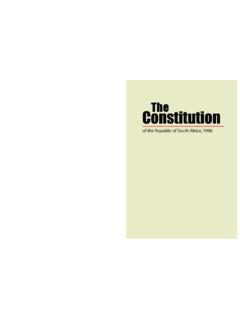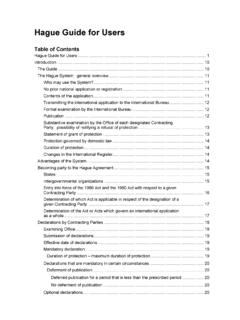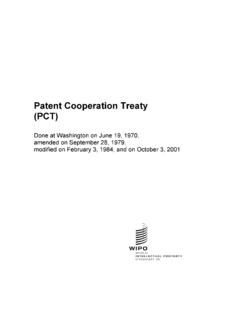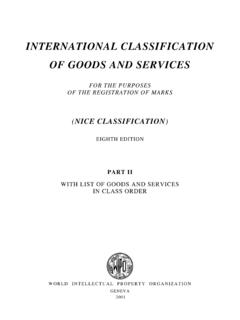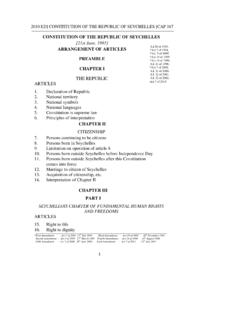Transcription of What is intellectual property? 2020 - WIPO
1 What is intellectual property ?Whatis IP?Please note: This booklet is not intended as a substitute for legal advice. Whatis IP?1IP covers a vast range of activities, and plays an important role in both cultural and economic life. This importance is recognized by various laws which protect intellectual property law is complicated: there are different laws relating to different types of IP, and different national laws in different countries and regions of the world as well as international booklet introduces the main types of IP and explains how the law protects them. It also introduces the work of the world intellectual property organization ( wipo ), the United Nations agency dedicated to making IP work for innovation and property (IP) refers to creations of the mind everything from works of art to inventions, computer programs to trademarks and other commercial is IP?
2 Whatis IP?2 Why does IP matter?The progress and well-being of humanity depend on our capacity to come up with new ideas and creations. Technological progress requires the development and application of new inventions, while a vibrant culture will constantly seek new ways to express property rights are also vital. Inventors, artists, scientists and businesses put a lot of time, money, energy and thought into developing their innovations and creations. To encourage them to do that, they need the chance to make a fair return on their investment. That means giving them rights to protect their intellectual rightsEssentially, intellectual property rights such as copyright, patents and trademarks can be viewed like any other property right. They allow the creators or owners of IP to benefit from their work or from their investment in a creation by giving them control over how their property is rights have long been recognized within various legal systems.
3 For example, patents to protect inventions were granted in Venice as far back as the fifteenth centur initiatives to protect IP through international law started with the Paris Convention for the Protection of Industrial property (1883) and the Berne Convention for the Protection of Literary and Artistic Works (1886).These days, there are more than 25 international treaties on IP administered by wipo . IP rights are also safeguarded by Article 27 of the Universal Declaration of Human and inventiveness are vital. They spur economic growth, create new jobs and industries, and enhance the quality and enjoyment of IP?3 Striking a balanceThe intellectual property system needs to balance the rights and interests of different groups: of creators and consumers; of businesses and their competitors; of high- and low-income efficient and fair IP system benefits everyone including ordinary users and consumers.
4 Some examples: The multibillion-dollar film, recording, publishing and software industries which bring pleasure to millions of people worldwide would not thrive without copyright protection. The patent system rewards researchers and inventors while also ensuring that they share their knowledge by making patent applications publicly available, which helps stimulate more innovation. Trademark protection discourages counterfeiting, so businesses can compete on a level playing field and users can be confident they are buying the genuine types and categories of IPIP is often divided into two main categories:Industrial property includes patents for inventions, industrial designs, trademarks and geographical and related rights cover literary, artistic and scientific works, including performances and types and categories of IPIP is often divided into two main categories:Industrial property includes patents for inventions, industrial designs, trademarks and geographical and related rights cover literary, artistic and scientific works, including performances and were one of the first types of intellectual property to be recognized in modern legal systems.
5 Today, patented inventions pervade every aspect of life, from electric lighting (patents held by Edison and Swa n) to the iPhone (patents held by Apple).PatentsBy patenting an invention, the patent owner gets exclusive rights over it, meaning that he or she can stop anyone from using, making or selling the invention without permission. The patent lasts for a limited period of time, generally 20 years. In return, the patent owner has to disclose full details of the invention in the published patent documents. Once the period of protection has come to an end, the invention becomes off patent, meaning anyone is free to make, sell or use this way, the patent system aims to benefit everyone: Firms and inventors can maximize profits from their inventions during the patent protection period. This rewards them for their effort and so encourages more innovation, which in turn benefits consumers and the general public.
6 Disclosure of the invention adds to the body of public knowledge, enabling and inspiring further research and can be patented?An invention can be defined as a product or process that offers a new way of doing something, or a new technical solution to a qualify for patent protection, an invention must be of some practical use and must offer something new which is not part of the existing body of knowledge in the relevant technical field (what lawyers call the prior art). But these requirements of utility and novelty are not enough; the invention must also involve an inventive step something non-obvious that could not just have been deduced by someone with average knowledge of the technical , the invention must not fall under non-patentable subject matter. Patent laws in many countries, for example, exclude scientific theories, mathematical methods, plant or animal varieties, discoveries of natural substances, commercial methods and methods of medical treatment (as opposed to medical products) as not generally a patentLike most IP rights, patents are territorial: protection is granted within a country under its national countries have somewhat different laws, but generally in order to gain protection, an inventor or firm will need to file an application with a patent office describing the invention clearly and in sufficient detail to allow someone with an average knowledge of the technical field to use or reproduce it.
7 Such descriptions usually include drawings, plans or application also contains various claims, that is, information to help determine the extent of protection to be granted by the patent. The application will then be examined by the patent office to determine if it qualifies for rights and enforcementPatent owners have the exclusive right to commercially make, sell, distribute, import and use their patented inventions within the territory covered by the patent during the period of may choose to make, sell or use the invention themselves, let someone else make or use it for a fee (known as licensing), or sell the patent outright to someone else who then becomes the patent owner. Or they may decide not to use the patented invention themselves, but to stop their competitors from using it during the patent someone else uses a patented invention without the patent owner s permission, the patent owner can seek to enforce the rights by suing for patent infringement in the relevant national court.
8 Courts usually have the power to stop infringing behavior and may also award financial compensation to the patent owner for the unauthorized use of the a patent can also be challenged in court, and if it is judged to be invalid, for example because the court decides it is insufficiently novel, it will be struck down and the owner will lose protection in that , regional and international protectionInventors and firms must decide in which territories they want patent protection. Each patent office usually charges fees for filing and processing applications, plus periodic fees for maintaining a patent once it has been cost of dealing with different national legal systems can be high, as laws and practices can vary widely and applicants will usually need to pay for representation by an authorized patent agent in each groups of countries have developed regional patent systems that help reduce these costs, for example the African Regional intellectual property organization (ARIPO).
9 Under most of these systems, an applicant requests protection for an invention in one or more countries in the group, and each country then decides whether to offer patent protection within its administers the PCT System, an international system that allows applicants to request protection under the Patent Cooperation Treaty in as many signatory states as they wish through a single designs8 These aesthetic aspects can be hugely important in the modern economy. Nowadays consumers face an enormous choice of products, including many that offer the same basic functionality. So they will tend to choose the one with the design they find most attractive within their price designs are applied to a wide variety of industrial products and handmade goods: cars, telephones, computers, packaging and containers, technical and medical instruments, watches, jewelry, electrical appliances, textile designs, and many other types of design rights cover those elements of a product that are aesthetic or ornamental the way it looks and designdesigns9 What designs can be protected?
10 Industrial design law only protects those aspects of a product that are ornamental; its technical features may be protected by patent, if they meet the requirements for patent design may consist of three-dimensional features, such as the shape or surface of an article, or two-dimensional features such as patterns, lines or qualify for protection as an industrial design under most national laws, the design must be new and show a degree of originality or individuality, meaning that it is not identical or very similar to any previous design. Moreover, it must be capable of being produced industrially, so unique artworks are not covered. designsIndustrial 10 Industrial design rightsIndustrial design rights entitle the right holder to control the commercial production, importation and sale of products with the protected with most other forms of IP, owners can exploit design rights themselves, or license or sell them to others, and can sue in the relevant national court to prevent infringement of their rights.

